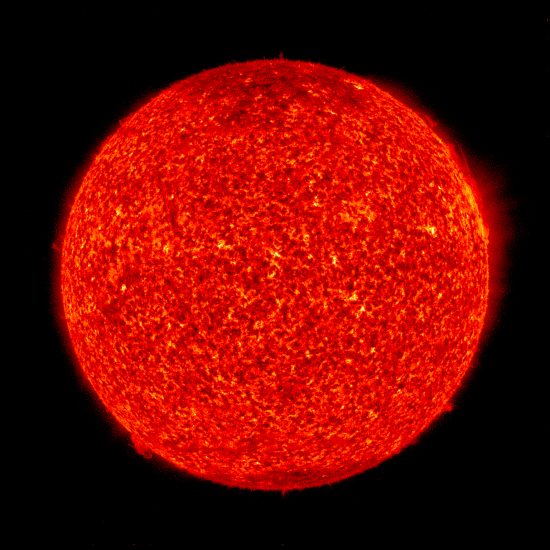
The quiet Sun on July 2, 2018. Credit: NASA Goddard Space Flight Center/Solar Dynamics Observatory (SDO), Atmospheric Imaging Assembly (AIA).
Jul 2, 2018
How does the Sun produce heat and light enough to sustain life on Earth?
Spectrograms of the Sun reveal that it is made-up almost entirely of hydrogen (71%), helium (27%) and some minute percentages of oxygen, nitrogen, sulfur, carbon, and six other elements. Every element is present in the Sun’s spectrum, but those 12 represent 99.9% of its composition.
The Sun’s mass is approximately 1.98 X 10^30 kilograms, with a diameter of 1,390,000 kilometers. The temperature measured at its surface is 5800 Kelvin. Conventional models suggest that the Sun generates outward radiation pressure, preventing gravity from compressing it into a solid ball. The theory proposes that an energy source exists inside the Sun, acting as a counter-force to gravitational contraction.
Although nuclear fusion was not thought-out until Hans Bethe developed the proton-proton reaction hypothesis in 1938, Sir Arthur Eddington in his book, The Internal Constitution of the Stars, believed that it could provide enough energy to power the Sun.
According to conventional understanding, the Sun condensed out of a nebular cloud that was compressed by gravity, until it reached ten million Kelvin. Hydrogen atoms are disrupted into individual protons and electrons at that temperature, leaving the protons free to collide with one another. It is these initial proton collisions, it is said, that are the first step in a reaction called the proton-proton (p-p) chain, as mentioned above.
When high-temperature protons collide, their inertia is enough to fuse them into other particles: deuterium, a positron and a neutrino. Deuterium is a proton-neutron combination, while a positron is a positively charged electron. Neutrinos are conventionally thought to be similar to electrons, except they do not carry an electric charge and are almost massless. Being neutral, they are said to not be affected by the electromagnetic forces that affect electrons. The second stage in the p-p reaction is the formation of a helium-3 nucleus when the deuterium captures another proton, while at the same time emitting a gamma ray. A helium-4 nucleus and two neutrinos are the end results of the reaction, although it can follow one of many different reaction paths.
Electric Universe advocate, Wal Thornhill provided a different perspective in his paper, Solar Neutrino Puzzle is Solved?
“It is simpler to assume that the energy we receive from the Sun is coming from where we see it – at the surface, or photosphere, rather than a minuscule and unlikely hydrogen bomb 93 million miles distant, shrouded in opaque gas. Then the fact that sunspots are dark makes perfect sense – it is cooler everywhere beneath the photosphere. Mysteriously generated magnetic fields are not required to explain every strange solar phenomenon and to defy the laws of physics in the process by breaking and ‘reconnecting’ hypothetical field lines. The surprisingly even magnetic field of the Sun, from the equator to the poles, is to be expected if the Sun is the focus of a cosmic electric discharge, as Ralph Juergens suggested 30 years ago. Magnetism cannot exist on the Sun without electric currents.”
Nuclear reactions are taking place on the surface of the Sun and not in its core. The solar wind is an electric current connecting the Sun with its family of planets and with its galactic clan, so the nearly 100-year-old theory of fusion firing the solar furnace should be reexamined under an electric light.
Stephen Smith












